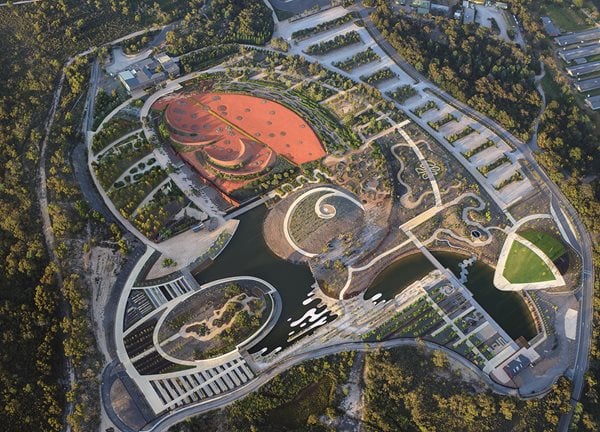A Metaphorical Journey through the Australian Landscape
Explore the Australian Garden, devoted purely to native Australian flora, at the Royal Botanic Gardens Cranbourne just outside of Melbourne.
By Sarah Hutchinson

Photo by: John Gollings
If you’re planning a trip to Australia, this sand quarry turned botanic garden should be on your itinerary. The Australian Garden at the Royal Botanic Gardens Cranbourne is devoted purely to native Australian flora. With its second phase opening just last year, you’ll be among the first to experience this unique landscape. Spring, which in Australia lasts from September to November, is the best time to visit. However, seeing the wattle trees blossom during the winter months is also quite striking.

Photo by: John Gollings
According to landscape architecture firm Taylor Cullity Lethlean (TCL) who, along with Paul Thompson, made up the lead design team, the completion of the Australian Garden allows visitors to take a metaphorical journey of water through the Australian landscape, from the desert interior to the fertile continental edge. A playful network of paths within the Eucalypt Walk evoke the patterns found on the trunks of Scribbly Gum Eucalyptus haemastoma.

Photo by: Ben Wrigley
The Eucalypt Walk is a series of band fingers, each band representing a characteristic of Australia’s eucalyptus species.

Photo by: Ben Wrigley
Nestled within the Eucalypt walk is ‘The Secrets of Lightness’ a sculptural installation by Janet Laurence, David Lancashire and Kate Cullity to commemorate the late Kevin Taylor’s (the T of TCL) contribution to the Australian Garden.

Photo by: John Gollings
This is where the journey through the Australian Garden begins. Australia’s dry interior has been abstracted into the Red Sand Garden, the centerpiece of the Australian Garden experience.

Photo by: John Gollings
The garden is noted for its large scale sculptural pieces, such as the Red Sand Garden, the Rockpool Waterway, the lily-pad bridge and the Melaleuca Spits. Shown here, the lily-pad bridge hovers above the lake connecting visitors to the Gondwana Garden.

Photo by: John Gollings
The Melaleuca Spits, consisting of parallel bands of Melaleucas arranged alongside abstracted sand spits, provide a threshold into the Coastal Edge Garden. When exploring this portion of the garden, look closely at the trees to notice how careful pruning techniques are being used to make them appear gnarly and windswept, as if they have been growing in harsh coastal conditions.

Photo by: Ben Wrigley
Don’t miss the Rockpool Waterway and escarpment wall sculpture designed by TCL and sculptor Greg Clarke. Dress children in quick drying clothes and water proof shoes so that they can enjoy the wading area.

Photo by: Ben Wrigley
Throughout the Australian Garden, a diversity of native flora provides varying texture, form and color. Perry Lethlean, Director of TCL points out that plants were selected not only for their suitability to low organic media, but also their adaptation to low water utilization and drought tolerance. This particular image was taken near the Dry River Bed.
Project Credits
Lead Design Team: Taylor Cullity Lethlean (TCL) and Paul Thompson; Engineering: Meinhardt; Cost Planning: DCWC; Soil Consultants: Robert van de Graaff; Lighting: Barry Webb and Associates; Irrigation: Irrigation Design Consultants; Water: Waterforms International; Sculpture – Ephermeral Lake: Mark Stoner and Edwina Kearney; Escarpment Wall: Greg Clark; Architecture – Visitor Center: Kerstin Thompson Architects; Architecture – Shelter stage 1: Gregory Burgess Architects; Architecture – shelter and kiosk stage 2: BKK
Project Credits
Lead Design Team: Taylor Cullity Lethlean (TCL) and Paul Thompson; Engineering: Meinhardt; Cost Planning: DCWC; Soil Consultants: Robert van de Graaff; Lighting: Barry Webb and Associates; Irrigation: Irrigation Design Consultants; Water: Waterforms International; Sculpture – Ephermeral Lake: Mark Stoner and Edwina Kearney; Escarpment Wall: Greg Clark; Architecture – Visitor Center: Kerstin Thompson Architects; Architecture – Shelter stage 1: Gregory Burgess Architects; Architecture – shelter and kiosk stage 2: BKK




